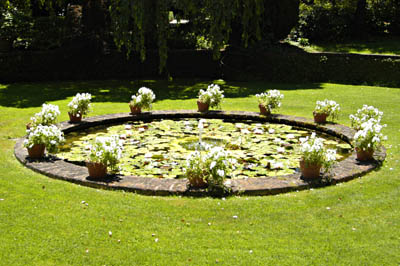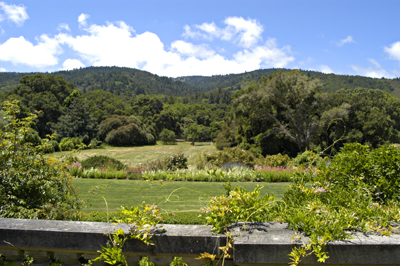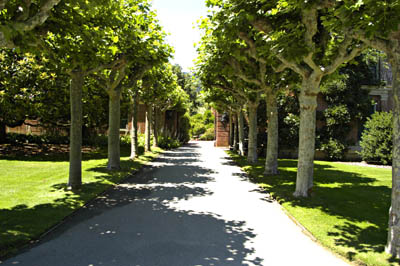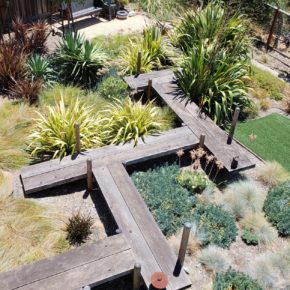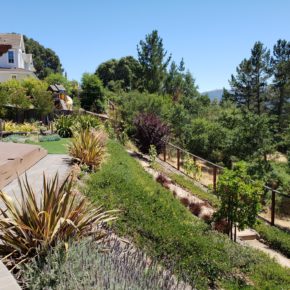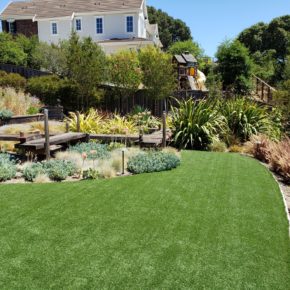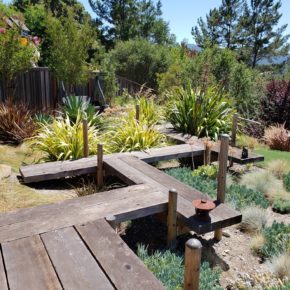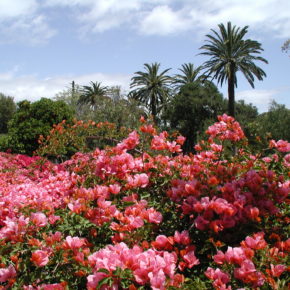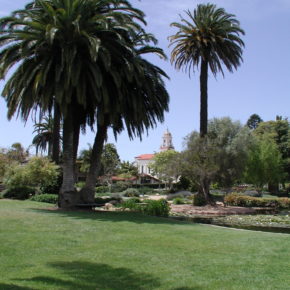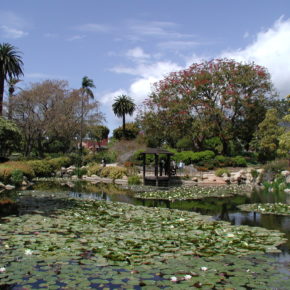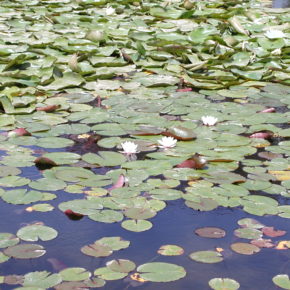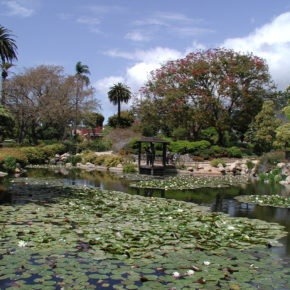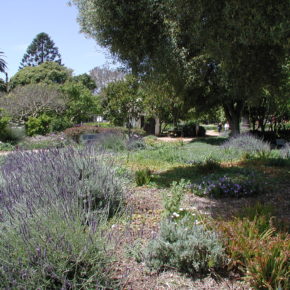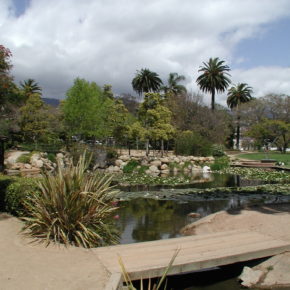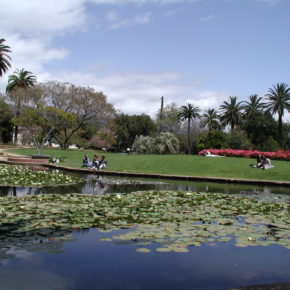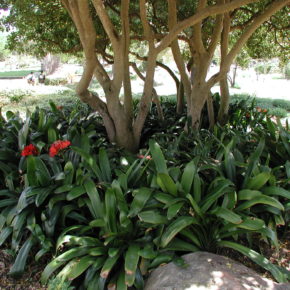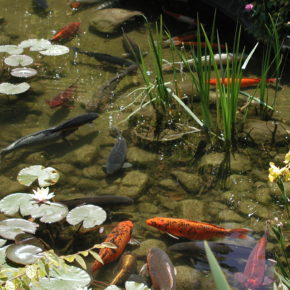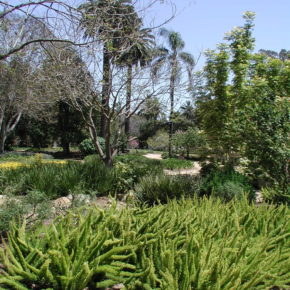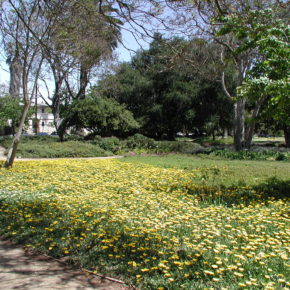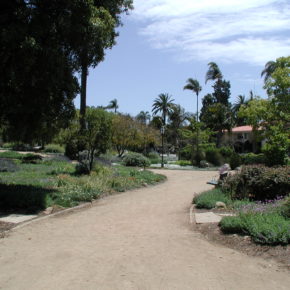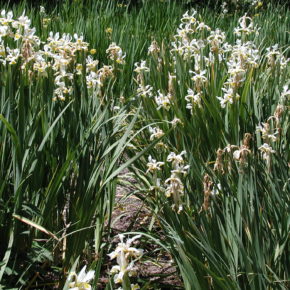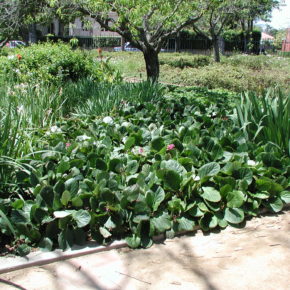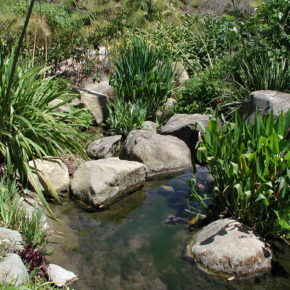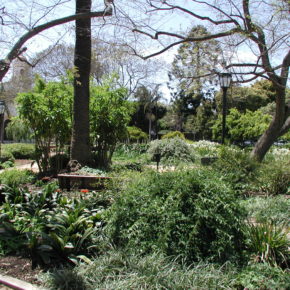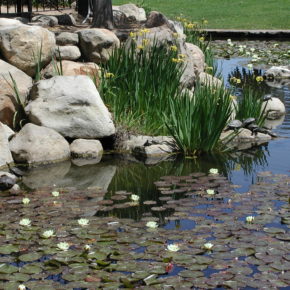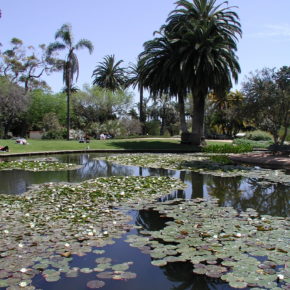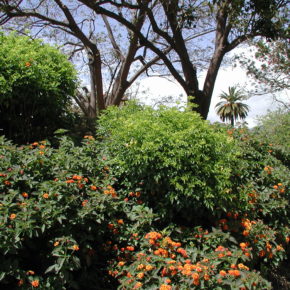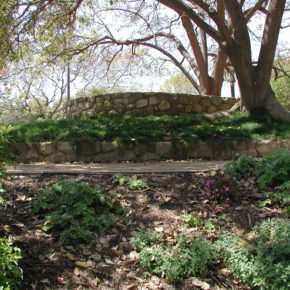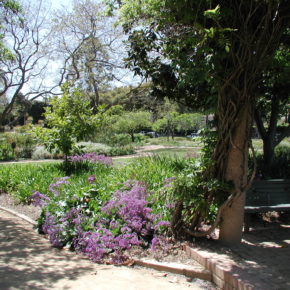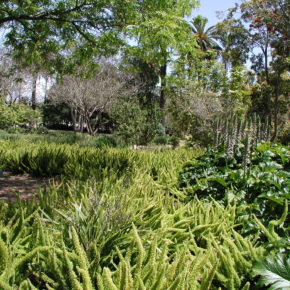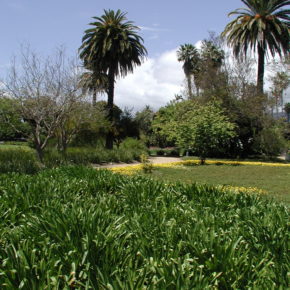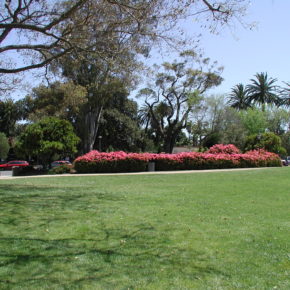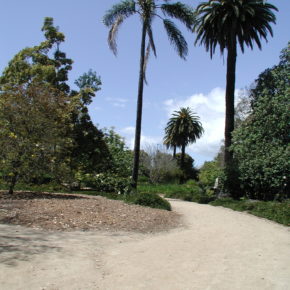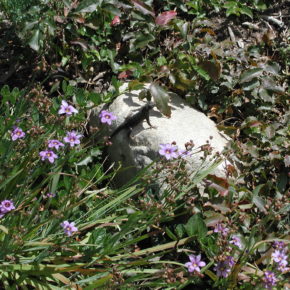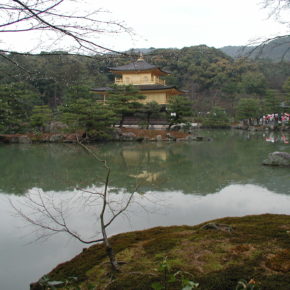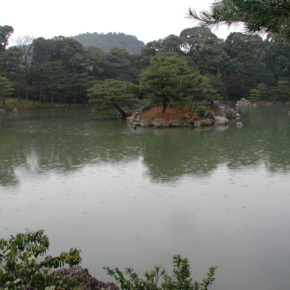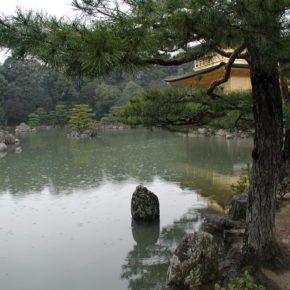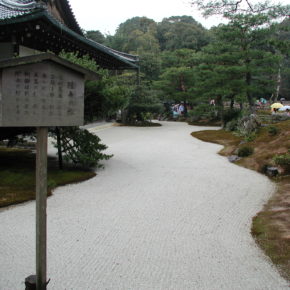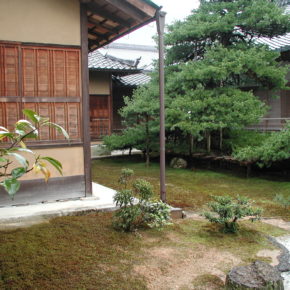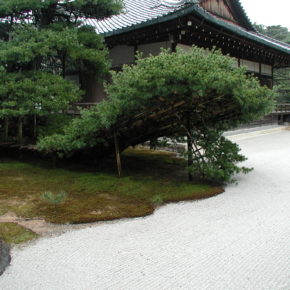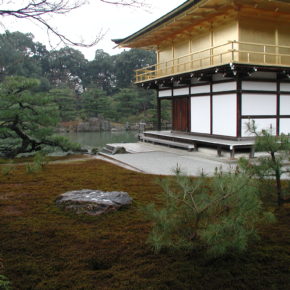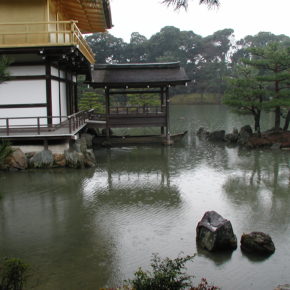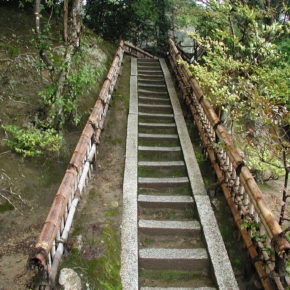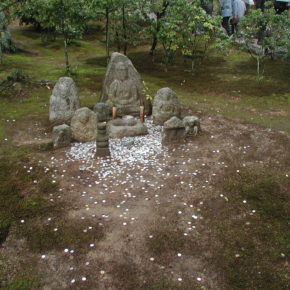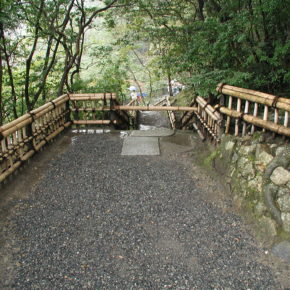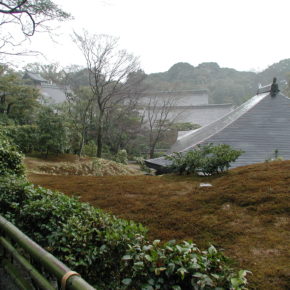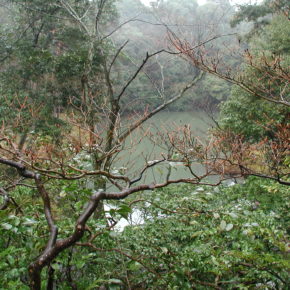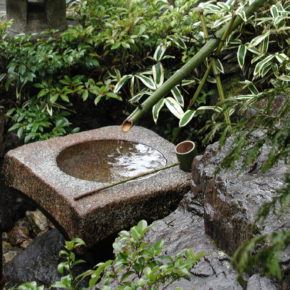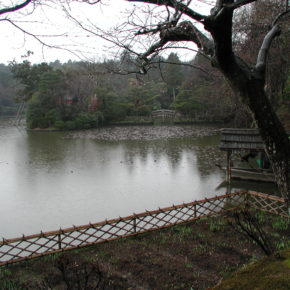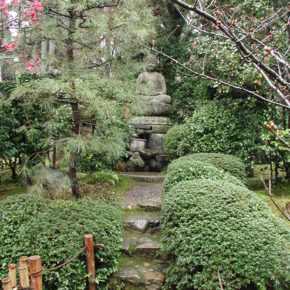It is always fun to visit a garden that we installed several years ago and see how the design vision and plants have matured over time. This project in Novato was a large multifaceted installation completed in 2013. The different areas have really come together as the plantings have matured.
Category Archives: Gardens
Alice Keck Park Memorial Gardens, Santa Barbara
Santa Barbara has such a unique style. With its more tropical plant palette and strong Spanish influences, it can be refreshing to draw some inspirations of Southern California into our landscapes. Alice Keck Park Memorial Gardens in downtown Santa Barbara features some interesting elements- decomposed granite pathways, stonework and boulders, ponds and open grassy areas as well as sections of plants that could be applied to a Northern California setting.
With our new website we’re reposting our great gardens and parks portfolios to our blog in a series of posts. Enjoy!
Our Demonstration Garden
Come visit our demonstration garden at our Petaluma office!
The garden is still under construction and features constant additions. Below are a few of the landscape installations we are featuring now.
–Smart irrigation Controller: with easy to use Solar Sync sensor that monitors and changes watering based on weather conditions
-Water Features: Self contained and in ground water feature samples
-Materials: Flagstone pathways, redwood fences and arbors, deer fences, decomposed granite and more
Time for a Winter Garden Tune-up
Winter time is a great time of year for work in the garden, especially in California. While it can be a little cold and wet, winter time is a good time to work on the bones of the garden. Replanting can be done in needed sections so plants are well rooted for spring growth. Pruning and trimming is best done now, when plants are dormant and most are done blooming. Irrigation systems can be checked and repaired so they are ready for the spring watering season and leaks and alterations are made. Slightly later in the season is a good time to fertilize plants to give them the nutrients they need for spring. While the garden may be dormant, this is a good time for the gardener or paid gardening service to get in some winter time care.
Spring Maintenance
Spring is officially upon us and that means it’s time, for those inclined, to roll up your sleeves and dig into the garden. One of the biggest items that may need attention is irrigation systems that have been shut off for the winter.
It’s a good idea to check controller settings, watering frequency and duration. A good way to find problems is to run through each station manually to make sure everything is getting water and there are no leaks.
De Young Museum Landscape- Impressions
The new De Young Museum in Golden Gate Park is a bold new addition to a park that is slowly reinventing itself. The De Young takes its place with the renovated Conservatory of Flowers and new sustainable model Academy of Sciences Building under onstruction, to make the face of the new Golden Gate Park. The De Young is the new crown jewel of the park, with its copper clad facades and controversial architectural form.
Looking at the landscape setting of the new De Young is a bit of mixed bag. Berkeley professor of Landscape Architecture Walter Hood sets the landscape as an understated collaborating piece to the architecture that is the true focus of the new museum. In some regard this is to be commended. The wild hills of poppies and ferns along the rear of the museum blend well with the feel of a wild and bohemian (under-maintained) Golden Gate Park.
Hood confirms this impression: “In a way the building [the new de Young Museum] is so loud that no matter what you do in the landscape it’s not going to be as loud as the building. At first I thought the landscape has to be its own thing, but there’s just no way it can be. It’s not large enough; it’s working at this in-between scale, in between the park and the building. How do you make this landscape an in-between space?” [Pruned Blog]
There are interesting detail elements: stained black wood mulch, chips and chunks of black stone mulch, a fence constructed of twigs and leaves. Inside the museum is an intriguing fractured bluestone entry (by Andy Goldsworthy), and a sculpture garden (with installation from light artist James Terrell) under the large cantilever of the museum that projects to the west.
Yet, somehow the grounds of the new museum do not live up to the
architecture. Part of this may be remedied with time and growth. The landscape and sculpture gardens do not have the same dynamic interaction, quality, and balance of a museum like the Getty. This is hardly a fair comparison from a monetary or spatial standpoint. Still, it seems the landscape could have been used to better effect.
The sculpture garden seems too small, plant selection in places seems to be struggling (Kafir lily, Camellia, and Ferns among others), and the landscape area and fountain to the east side are much more pleasing in plan view from the museum’s tower than they are on the ground.
In a park clearly showing its age and slowly being reborn, it will be
interesting to see how the new addition of the De Young landscape matures and ages. Will it become like Union Square- a garish collaboration of materials with little usability and durability. Or, will it mature into a graceful backdrop to the slow patina of the new museum it seeks to dress- time will tell.
For More:
-The Hybrid Spaces of Walter Hood
–Pruned Blog- “The Peacemaker”
Striking Images from Germany’s Duisberg Nord
Duisburg Nord is one of Germany’s groundbreaking parks
that took an old steel production district and transformed it into a park. The juxtaposition of old hulking rusted equipment and new park features make for an unique experience.
An overview from their website:
If you are looking for recreation, an exciting experience, education or fun, the Duisburg-Nord Country Park is all you need. At a site where the blast furnace heat was almost unbearable you can now cool down and relax. Young trees and old furnaces overlook a park for everybody and everything – and even more, as you can simply climb to the roof of the Ruhr and enjoy the view, experience top events live in a factory building or track regional history in a world of steel. Welcome to Park Land without frontiers.


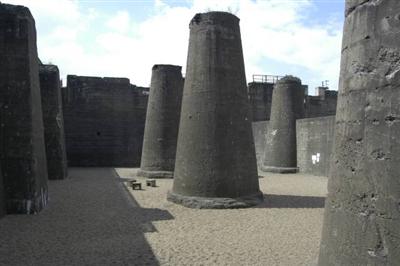

This park has served as an interesting model for other post-industrial cities looking to redevelop their old manufacturing areas.
For More Images:
Details from Gardenvisit
Rhododendrons from the Mendocino Botanical Gardens
Here are photographs of beautiful spring rhodys from a recent trip to the Mendocino Botanical Gardens. The cool coast air and moist climate make for beautiful specimens. One other interesting specimen was a Coast Redwood at the gardens. Redwoods do not grow well when exposed to salt air, and as a result don’t thrive on the coast.
A Coast Redwood with stunted growth as a result of salt exposure near the
coast
The beautifully rugged Mendocino coast
Gardens of Kyoto- Nijo Castle
Castles do not just grace medieval Europe. The Japanese
Castle was a thriving architectural form in medieval Japan as well.
The most striking example of Japanese castle building is Himeji
Castle a UNESCO world heritage site. Within Kyoto, Nijo Castle is another striking example of Japanese castle construction. From a landscape perspective, the layout of Nijo’s gardens, moats and impressive stone walls create an interesting contrast from the
multitude of temple and shrine gardens in Kyoto.
Nijo’s most striking aspect is the bone of most Japanese gardens, its amazing stone work. Both the boulder arrangements and castle walls are amazing.
For More:
City of Kyoto Brochure for Nijo Castle (Part 1 & Part 2)
Jgarden.org
profile
Wikipedia article
Gardens of Kyoto- Daisenin
Daisenin is the more enigmatic garden counterpart to the clean lines of Ryoan-ji. Another “Zen Garden” with its dry raked gravel, Daisenin has an intimacy and series of boardwalks that give a serial, sequential feel to its spaces. The piles of gravel in the main garden have the appearance of a hybrid, somewhere between that of Ginkaku-ji perfection and Ryoan-ji gravel and stones.
For more:
Great Analysis of the Garden from Jgarden.org
Japanese Based Page with good information on the evolution of the Japanese Garden
Gardens of Kyoto- Ryoan-ji
Ryoan-ji (meaning “The Temple of the Peaceful Dragon”) is the archetypal Japanese rock garden. The small table top rock gardens that have become popular owe their inspiration in part to the 15th century anonymous karesansui masterpiece of Ryoan-ji. The garden has a unique axial configuration, so that, from any fixed point on the ground, one cannot see all of the stones in the garden. It is the ultimate rock garden of contemplation.
For More:
Profile at JGarden.org
Article from New
Scientist about Ryoan-ji’s appeal
Article about adding elements of Zen Garden design to
garden projects
Gardens of Kyoto- Kinkaku-ji
Kinkaku-ji, or the Golden Pavilion is another of Kyoto’s most famous historical pieces of architecture (in 1994 it was designated a UNESCO World Heritage Site). It is interesting to contrast Ginkaku-ji, with its large Silver Sea of gravel, with the layout and actual pond of the Golden Pavilion.
The Silver Pavilion of Ginkaku-ji was an homage to the more elaborate Golden Pavilion. Historically, however the Silver Pavilion holds significance as an original structure, whereas the Golden Pavilion has been reconstructed after being burned in 1950.
The fusion of architecture and the surrounding landscape in these temples and shrines is amazing. It is interesting how Frank Lloyd
Wright’s methodology of organic architecture parallels the incorporation of the design and layout of the building to its surroundings in a similar way to these Japanese pieces.
For More:
Kinkaku-ji official site
Wikipedia article
Gardens of Japan- Ginkaku-ji
Kyoto the historical capital of Japan (prior to the move of power to Tokyo in the 19th century), is a striking city full of history and captivating gardens. One of the best preserved major cities in Japan (surviving World War II), it features a wealth of shrines, temples and gardens.
The Silver Pavilion, or Ginkaku-ji, is one Kyoto’s most famous temples and houses one of the city’s greatest gardens. The striking piles of raked and formed mounds of gravel and stone are wonders to behold. The Silver Pavilion itself is a rare original example of architecture from its period. Often temples and shrines were burned by feuding Shoguns and many have been reconstructed numerous times.
The entrance to the temple complex features a two story Camellia hedge, precisely clipped and indicative of the meticulous nature of the gardens inside. Once inside the Karesansui forms are like nothing else in the gardens of Kyoto. The craft here is amazing, and the raked gravel takes on an appearance of solid mass that should be impossible.
For More:
Details from Wikipedia
Jgarden.org index of Japanese Gardens
Garden Magazines- Be Careful What You Wish For
We receive several design and garden magazines in the office (Sunset, Pacific Horticulture, Horticulture, Garden Design, Landscape Architecture and Fine Gardening just to name a few) They are great places to get ideas and see what is new and avante garde in terms of plants and hardscape features.
After reading through this month’s Sunset and looking at some of the Beautiful garden samples, a reoccurring thought struck me- the garden I was looking at in the photographs probably only looks this good 15 days out of the year.
This is a good thing to watch for when looking through these magazines. That beautiful plant in the featured article looks great, but is it evergreen or deciduous? Does it require low or high maintenance? Is it something that deer find to be equivalent to caviar? Often the planting compositions are complex blends of grass, perennials and annual flowers, that look great but require heavy maintenance.
The same can be said for hardscape. It is my experience that expensive, large projects photograph for print publication the best. Before you set your heart on that 1000 square foot travertine patio with vanishing edge pool and outdoor kitchen, take into consideration what it would take to install these type of elements for your project.
A good example was a client who wanted Golden Barrel Cactus, similar to the distinctive garden at the Getty Center, until we priced them out, and found that the cactus alone would exceed their planting budget.

At several hundred dollars a piece these golden
barrels might break the bank
A Hefty and Winning Garden Retrospective
While perusing through Borders Books for a gift for a colleague I stumbled upon Mick Hales, Gardens Around the World: 365 Days a wonderfully photographed and comprehensive volume of gardens from, as the title says, around the world. The book has distinctive photographs of gardens, which, as the introduction points out, capture each garden’s essence well. As anyone who has photographed gardens will know, this is not an easy task, especially in small spaces. This book would be especially useful for those looking for inspirational images to use for establishing a style of garden design, or as inspiration for travel plans.
Plus, at the size of an oversized brick, this compact yet dense volume can serve well if the reader is accosted by a dinner guest who has had a bit too much wine.

Cover Image Courtesy Amazon
2006 Gardens of Europe Calendar
We are getting ready to mail out our 2006 Gardens of Europe Calendar. The
Calendar features my photographs from my travels in Europe in 2003, many of
which can be seen in our Great
Gardens and Parks Portfolios. If you would like a free copy of the
calendar please send us an email with your name and address.
Have a great Thanksgiving!
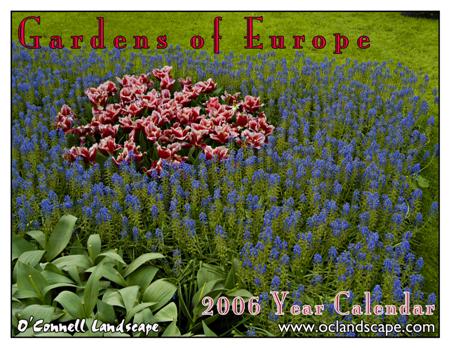
The
Cover
Some
of the Monthly Images

Find Ideas for your Landscape at the Local Winery
After spending part of this weekend visiting friends in the Healdsburg area
and visiting various wineries for the Russian River Wine Road Food and Wine Festival, I was
struck by what a good resource wineries are for landscape inspiration. Where
else could you find estate sized gardens, well articulated, with typically free
admission and free wine to boot? Now obviously for readers outside of a wine
region this may be less of a possibility. Luckily for Bay Area residents we live
on the doorstep of the great wine regions of Sonoma County.
Winery gardens vary in their scope and style, but many tend to be of
Mediterranean/Italianate villa inspiration and incorporate fountains, outdoor
dining areas, and a wide variety of plants and materials. For smaller residences
the budget may not be the same as a large winery, but cues for stylistic
elements abound.
For more:
Healdsburg Area Wineries
Sonoma County
Wineries Assocation
Posted by Michael O’Connell at 08:46 PM | Comments (0)
Real Goods Solar Living Center
Below is a profile for Real Goods- A alternative energy center and
gardens located in Hopland, California.
Project Type:
Retail sustainable goods outlet/ Non-
Profit Institute for solar and sustainable technologies, 12 Acres in size
Designers:
Architect: Sim Van
der Ryn
Landscape Architects: Stephanie Kotin and Chris
Tebbutt
Completed June 1996
Contact:
Website: http://www.realgoods.com/
Address: 13771 South
Highway 101 Hopland, CA 95449
Phone: (888) 212-5640
Project Background:
The Real Goods Solar Living center is
the vision of John Schaeffer, the founder of the sustainable products company
Real Goods. Located about 90 miles north of San Francisco, the center
encompasses three distinct elements: The 5000 square foot Real Goods retail
store, the Solar Living Center- a non-profit educational and research division
of Real Goods, and Solar 2000, a 132 kilowatt solar array, which is one of the
largest solar power sites in Northern California. Real Goods is a mail-order
based company, which had over 18 million dollars in sales in 1996 when the
center opened. The project was built as a model for the use of sustainable
energy technologies, building materials, and a showcase for the company’s
products. The Solar Living Center manages the facilities and grounds and focuses
on educational workshops and continuing research. This includes the promotion of
sustainable building materials and techniques, permaculture, and sustainable
landscape design.
Project Design:
Sustainable design of both the
architecture and the landscape was of foremost importance for the center. The
site selected along Highway 101 in Hopland, lies in a 20 year flood plain and at
the time of purchase was a CalTrans dumpsite. The husband-wife landscape
architecture team of Stephanie Kotin and Chris Tebbutt transformed what was a
bare, noisy site into an interesting and lush oasis with as much landscape
meaning as interesting form. Solar energy panels are built into and featured
within the grounds of the center and incorporate the ideas of sustainable energy
use directly into the landscape. Distinct design elements such as incorporation
of the cardinal directions as distinct axis, a solar calendar, a central
artesian well and stream, and a large pond and wetland are all designed together
into an inclusive package, rich with symbolism and artistry. Throughout the site
individual design elements speak to the message and artistic quality of the
grounds. One poignant example of these elements is the Memorial Car Grove. The
grove contains old rusting muscle cars that have had holes cut in the roofs to
allow trees to grow through. Elements such as this show a rich synthesis of
message with form.
Sources:
–A Place in the Sun– the book about the creation of
Real Goods
-Personal Site Visit
For More:
–Review of A Place in the Sun
–Van Der Ryn
Architects
Reflections on the Getty Center, Los Angeles
What would you do with a billion dollar building budget? That was the question administrators and architect Richard Meier had to answer when taking on the building of the Getty Center, an art museum and research facility in Santa Monica. The center whose architecture and layout was principally designed by Meier, sits on a majestic hilltop surveying the entire Los Angeles basin. The Center is mainly composed of a central group of buildings, and is complemented with smaller garden primarily designed by environmental artist Robert Irwin. While the Center constitutes a great endeavor as both a piece of architecture and as a museum, there is something missing, something that its billions could not buy.
This is not to say that the Getty Center is a failure or is not a great facility, for indeed it truly is amazing by any circumstances. However, having been to the likes of the National Gallery in Washington D.C. and the unparalleled Louvre in Paris, my expectations for the Getty were high when I visited one sun scorched afternoon. The main problem observed with the Getty is its inability to put its many and complicated parts together into an effective whole. Among the major observed problems were a lack of unity of buildings and a poor interrelation between the buildings and garden.
First of these faults is the poor cohesiveness in the built form. Meier’s architecture attempts to be overpowering and grandiose with its modernist and classical allusions, yet it lacks the bold vision that would have made it successful. Architecturally the buildings seemed to be too concerned with alternating forms and materials than in really making one statement. Meier has his buildings undulating and changing between a variety of different basic forms; this is in addition to changing materials between travertine rock and aluminum paneling, which is distracting and detracting. The result is a building that makes no clear statement, and whose facades look as if they were two designs melded together. It might have been better if Meier had gone with more modernist ideals of simplicity and purity in form. In this way the Getty Center might have had a more universal and powerful appeal.
The overall composition of the center also shows weakness in the relationship between the gardens and buildings. The gardens of the Getty make their own statement that intentionally veers from Meier’s vision. The designer of the garden Robert Irwin had many fights with Meier over form and relationship of the garden. Ultimately Irwin chose his own independent design vision. While Irwin’s garden by itself is quite impressive it fails to hold its own and blend successfully with Meier’s buildings. The gardens do not have equal footing with the buildings, and as a result the garden is put in a subordinate and not a complementary role. Its forms while interesting and effective, do not play off the architecture in an effective manner.
Overall, the Getty Center is an impressive complex and is obviously poised to make a huge contribution to the world of art. Yet from the standpoint of form and space it leaves much to be desired. It seems as if the Getty Trust tried to do a little bit of everything and lacked focus in making the place exude one expressive and unifying feeling. Unfortunately Meier could not do what I.M. Pei did for the Louvre. Pei was able to combine design theories, philosophies and histories, as well as differing forms into a bold and unique design expression. Meier and the Getty Center did not succeed to the same degree in their pursuits, and this lack of unity detracts from the Museum’s experience.
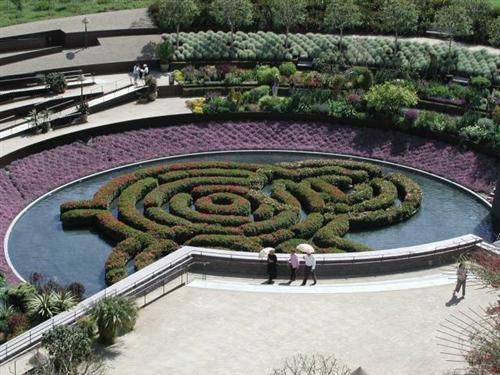
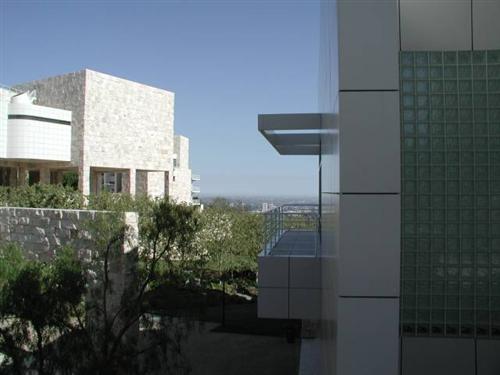
For More:
Getty Center Website
Richard Meier & Partners Website
Sources:
Perl, Jed. “Acropolis Now.” New Republic 26 Jan. 1998: 25+.
Beardsley, John. Earthworks and Beyond. New York. Abbeville Press. 1998.
The Irish Formal Garden: Powerscourt
Ireland is not usually the first place considered when mentioning outstanding formal gardens. The gardens of Ireland are not regarded in the same light as those of nearby England, or those sublime landscapes of the continent, such as France or Italy. Yet, in this beautiful emerald isle lie some of the most beautiful and interesting gardens to be found anywhere in the world. The Irish
garden is a compilation. Often employing English style, as the English occupied the country and still exert their influence over the north to the present day, the Irish garden translates that style, as well as those of other European and international influences. Ireland has made these adapted styles into her own, and the nature of the Irish garden has a distinction that differs it from those
of England or the rest of Europe.
The gardens at the Powerscourt estate embody many of these characteristic elements very well. Powerscourt stands out by being different than many other famous Irish gardens. The gardens are important in that the overall design is very formal, they incorporate these formal traits in a way reminiscent of Italian and French garden design, and they bring together all these varied and complex traits into a cohesive whole.
Upon examining the typical Irish garden, it becomes clear that the Irish did embrace the more pastoral romantic landscapes of England that began to develop at the beginning of the 1700’s. These influences clearly had a great effect especially on gardens of the ninetieth century, and it is this more informal style that tends to dominate Irish landscape design of the most famous gardens.
It is this tendency toward the more organic designs of English style that causes such a distinction and contrast in the fewer formal Irish gardens. This is not to say that formal gardening was not a part of the design vocabulary of Ireland, for it was. Victorian designers such as Sir Charles Barry and William Nesfield were using elements Italian style in their garden designs as the backbone of their work. Yet those landscapes of particular distinction and fame in Ireland follow the path laid by famous Irish landscape gardener William Robinson. Robinson’s effect on the design theory of Ireland was similar to the more famous English names of Wise, Kent, Brown and others who pushed the transition to the Romantic, free-flowing, naturalistic garden. As a result the Irish garden, never fully developed an articulated formal style that gained widespread recognition like the more natural gardens that would follow. Still, there were exceptions to this overall trend in development of garden theory, and the gardens at Powerscourt are one of them.
Situated fifteen miles away from the capital city of Dublin in Wicklow County, the estate was the home of the Viscount of
Powerscourt. Encompassing at its peak 36,000 acres, the estate was quite large and provided great opportunities for building and landscape formation. The existing estate was finished in 1770, (although the interior was burned out in a fire in 1974), and from that point the rest of the grounds began to develop. The sixth Viscount of Powerscourt began development of the grounds as a start of their eventual modern form, but it wasn’t until his son Richard, the seventh Viscount of Powerscourt, took over the estate after his father’s death, that estate’s grounds really begin to metamorphose. Through a somewhat complicated series of designers and incarnations, the grounds surrounding the Manor began to take on the shape that they still retain today.
The gardens owe they’re splendor and grandeur mainly to this principal patron, Richard Wingfield the seventh Viscount. His travels to the gardens of Europe, especially those to Versailles, Schönubrunn, and Schwetzingen, had a profound impact on the overall form of the garden. It is because of these travels that the gardens at Powerscourt show such interesting similarities with
these more mainstream gardens and their design elements and philosophies. The gardens at Powerscourt, like Irish gardening in general, incorporated all these influences while maintaining an individuality that gives the grounds a uniqueness and overall sense of place.
The actual design work of Powerscourt was done by a number of designers starting with architect Daniel Robertson. It was Robertson’s overall vision that would set the backbone for what Powerscourt would become. Robertson worked for the sixth Viscount and although he and the Viscount would die before they’re plans were realized, the foundation was set for what was to occur next. Robertson was responsible for the layout of the rounded series of terraces and the incorporation of the existing water elements in the overall design. Robertson also was responsible for the formal Italian design of the gardens that he supposedly emulated from the Villa Butera in Sicily.
The transition in designers following Daniel Robertson’s death meant a fourteen year reprieve from development and it wasn’t until 1854 that the Viscount’s son and Scottish gardener Alexander Robertson (no relation) would team up and continue development of the estate. Alexander Robertson continued and adapted the vision of his predecessor and development progressed. It was under the steady hand, and bold vision of the new Viscount that work continued although Alexander Roberson also died in 1860. The Viscount then entertained plans from four other designers, and the combination of their work continued to develop the project and its specific details. The first of these was James Howe who continued to develop the semantics of the terraced gardens, and who unfortunately died a year after his Powerscourt plan was created. Later designers followed including Broderick Thomas and Lord Powerscourt’s neighbor Sir George Hodson. These designers continued to articulate the gardens as the design process foraged on.
The result of these no less than six designers and the two lords was nothing less than fabulous. Through its development, Powerscourt developed into one of the most distinctive and interesting gardens in Ireland, and for that matter in Europe in general. The site was a microcosm of European design styles, yet with the unique setting of the rich chromatic green of the Irish landscape, and the backing of Sugar Loaf mountain in the distance the estate achieved something
more than its individual design elements could ever achieve alone.
Distinctive elements of the formal gardens include a beautifully constructed perron designed by Francis Penrose. The perron evokes visions of Italian designs in its style and beauty, using scores of small stones of black and white set eloquently into the terraced steps. This and other elements enriched the gardens’ already strong formal European feeling. Copies of many famous statues like the Hellenistic
Greek statue of Laocoon, ornament the many terraces of the grounds and give the gardens a very continental flavor reminiscent of other famous formal gardens such as Vaux le Vicomte.
Detail is present everywhere in the site, from the beautifully crafted
statuary to the magnificent intricacies of contorting wrought iron shaped in a multitude of elegant forms. Two bold statues of the winged horse Pegasus accent the central pond and are very distinctive in design and have their origins in the Powerscourt coat of arms. Beauty abounds and there is a good cohesion in site between built form and landscape. The landscape functions well as an overall setting and extension of the manor.
Here at Powerscourt is the unheralded Irish formal garden in all its glory. It is this somewhat unique niche of formality that gives Powerscourt its distinction and importance. The garden succeeded in creating a formal atmosphere, and yet with additional gardens such as a Japanese garden addition, and a flawless integration with the more informal countryside and other informal gardens, there was a creation of something larger. With its unique setting and properly fit elements, Powerscourt transcends the ordinary; and when on site or looking at photographs it can become an almost surreal work of art.
The gardens succeed in carrying on the tradition of the Italian Villa and French Chateau. Renaissance architect Alberti would be proud, as the estate conforms wonderfully to his guidelines for villa planning that a site should be oriented towards “familiar mountains”, such as are found in Sugar Loaf looming picturesquely in the distances that lie beyond as Alberti put it, “the delicacy of the gardens”. It has the open feel of Versailles while at the same time
combining the curvilinear themes of the romantic pastoral English designers using its contextual setting. It is a work of combination, done perfectly to create something that is more than its individual styles. The gardens don’t have their own distinct style, and yet they do in their inclusion of all the aforementioned elements. It is in this characteristic that Powerscourt achieves greatness. It is the unlikely formation of a great formal garden in a country not known for its articulation in this aspect of garden design. This contrarian gesture of design against the popular preconception of the Irish garden is what makes Powerscourt grand.

Sources:
1. Hyams, Edward. Irish Gardens. London: Macdonald, 1967.
2. Malins, Edward, Patrick Bowe. Irish Gardens and Demesnes from 1830. New York: Rizzoli,1980.
The Allure of the Japanese Rock Garden
For people outside eastern cultures there is a certain allure, especially from those who appreciate gardens and landscape design, in the Japanese rock garden. In its stark simplicity, the Japanese rock garden is easy to behold. Yet it is its deeper meaning that gives it the aesthetic qualities and universal appeal that many people find so attractive. The rock garden is a highly spiritual statement. At first glance it may seem as merely ornamental style, yet a deep significance lies in its form and layout. The rock garden is a metaphor
for something greater. The garden is a microcosm and distinct statement about life. It is a minimalist reduction of clarity and purity. The gardens at Ryoan-Ji are probably the most famous and noteworthy of these qualities. Strength and appeal lie in their mystery and their pervasive simplicity.
The Japanese rock garden is like a poem, free to interpretation by anyone who cares to venture an opinion and in this aspect lies part of its strength. A child may see a sandbox, an intellectual, the metaphor for perfection in the universe, the Zen philosopher may see just rocks. Most critics consider Ryoan-Ji as the prototype for the rock garden. All of 15 rocks and 330 square meters create the masterwork of Japanese Kare-sansui, or dry gardening. This reinforces the fact that Japanese rock gardens are not gardens of massive size or physical complexity. Their overall significance lies on a transcendental plane.
The contrast to western styles and meaning may also shed some light as to their popularity. The typical garden design philosophy of most western gardens is that of central meaning and conceptual philosophy. The Japanese garden reflects more of cryptic and deeply philosophical thought. There is no greater statement than saying nothing at all, for it allows the mind to complete the scene. The rock garden is an allegory, yet one with a meaning that is as elusive
as the meaning of life itself.
Another interesting caveat in Japanese rock gardening is the symbolic raking of sand as a symbol for water. This aspect has allure in its interactivity and in its interesting patterning. What’s particularly interesting about this element is its entry into American culture through small Zen rock kits. A piece of cardboard, some sand, a few small stones, and a rake is all that is needed to
achieve ones own inner enlightenment. While there is commercialism and often a lack of full understanding that often accompanies the use of these kits, they show the general appeal of the concept and basic philosophy.
The rock garden then is a place of thought and a place for reflection and meditation. Through its simplistic forms it provokes thought, reflects the design concepts of an entire genre of gardens, and gives a clue into Japanese Zen and naturalistic philosophies. Dynamic yet simple, full of contrast, the rock garden speaks volumes with every grain of sand. Unique in character and quite recognizable, it has maintained its appeal as garden form, and continues to fascinate people, as it will for generations to come.
Kyoto’s Famous Ryoan-Ji
Sources:
Moore, Charles, William Mitchell, William Turnbull Jr. The Poetics of
Gardens. Cambridge. MIT Press. 1988.
Bring, Mitchell, Josse Wayembergh. Japanese Gardens. New York. McGraw-Hill.
1981.
Cornerstone Gardens, Sonoma
Cornerstone Gardens is a good resource for those looking inspiration to
incorporate a sense of the modern avante-garde into landscapes of a residential
scale. The Gardens, located just south of the City of Sonoma, feature the works
of 20 well known landscape architects. These gardens truly seek to develop the
landscape as art, making bold visual statements.
Visit Cornerstone’s Website for more information on the Gardens and their
designers.
Newly Expanded Great Gardens and Parks Portfolios
After much work and web toiling, we are happy to present our newly expanded
Great Gardens and Parks portfolios. Here you will find
gardens from California and the West, and Western Europe.
In the California and the West Galleries there are 15 galleries from gardens,
parks and city spaces from British Colombia to Southern California. In the
Western Europe Galleries there are over 20 galleries from 7 countries.
We hope that these galleries can serve as an information resource, and that
they will be enjoyable to browse through. As with any web based project there is
more on the way from Western Europe, and eventually from our travels in Kyoto
Japan and surrounding areas.
Prado Museum Botanical Gardens, Madrid
The Prado Museum hosts one of Europe’s great art
collections. It is renoun, for its collection of Spanish Masters Goya, El
Greco and Velasquez. In addition to the museum there is also an
interesting botanical garden on the grounds. The Prado was originally
comissioned in the 18th century to be natural science museum, which accounts for
the botanical gardens, but by the time of its opening, it was used as a showcase
of art from the Spanish empire.
The garden itself has a characteristic Spanish quality of being relaxed and a
bit wild and overgrown. This is true of many of the other parks of Madrid that I
visited. Below are some photographs-
Keukenhof Gardens
In the process of moving to our new office, I was reviewing some of my
photographs of gardens in Europe from 2003. One of the most striking of all the
gardens I visited there was the famous Keukenhof Gardens in Lisse, Holland. Of course, the
Dutch are famous for their flowers, especially their tulips, and the gardens did
not disappoint. There are acres of beautiful gardens that should be a must on
any Netherlands visit.
As far as floral displays, from my travels these gardens may only be rivaled
by the Butchart Gardens in Victoria, British Colombia.
Below are some of my favorite photos from the gardens:
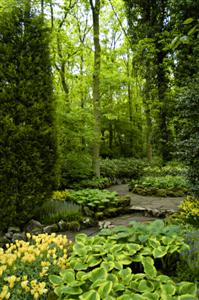
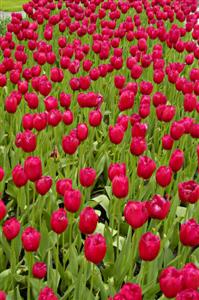
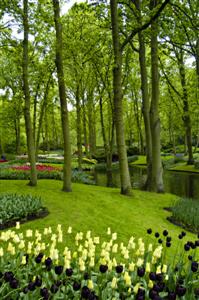
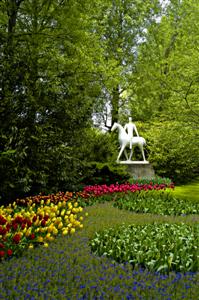
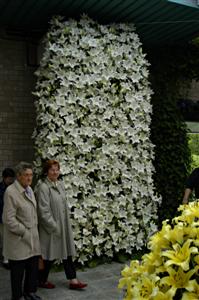

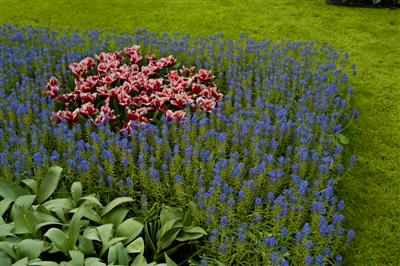
Good Garden Quotations
In the process of our move to our new office, as I was filtering through some books I stumbled up Maria Polushkin Robbins’ book A Gardener’s Bouquet of Quotations, and I wanted to share a few of my favorites.
A Garden is a thing of beauty and a job forever.
-Anonymous
Nothing is more completely the child of art than a garden.
-Sir Walter Scott
I don’t know whether nice people tend to grow roses or growing roses
makes people nice.
-Rowland A. Browne
The great challenge for the garden designer is not to make the garden
look natural, but to make the garden so that the people in it will feel
natural.
-Lawrence Halprin
But a weed is simply a plant that wants to grow where people want
something else. In blaming nature, people mistake the culprit. Weeds are
people’s idea, not nature’s.
-Anonymous
Again rejoicing Nature sees
Her robe assume its vernal hues
Her
leafy locks wave in the breeze,
All freshly steeped in morning
dews.
-Robert Burns
As is the garden such is the gardener.
A man’s nature runs either to
herbs or weeds.
-Francis Bacon
The nation that destroys its soil destroys itself.
-Franklin D. Roosevelt
Unless you take care, the sun will pin you down. Put a hat on that
foolish head of yours when you go out into the fields.
-Farmers Almanac
He who plants a garden, plants happiness.
-Chinese
Proverb
There is nothing pleasanter than spading when the ground is soft and
damp.
-John Steinbeck
What I enjoy is not the fruits alone, but I also enjoy the soil itself,
its nature and its power.
-Cicero
We collect great garden quotes, let us know some of your favorites.
If you are looking for more good quotes try:
Quote Garden
An Interesting Japanese Garden
There was an interesting article about Japanese gardens today in the San Francisco chronicle. Osmosis, a Japanese Spa retreat in Sonoma County has some beautiful Japanese gardens created by Osmosis founder Michael Stusser after a garden apprenticeship spent in Kyoto.
For good local examples of Japanese gardens this may be a good place to visit. The garden is only open to spa guests, except when they have special events, such as concerts.
Making an authentic looking Japanese garden is not an easy task. I took a trip to Kyoto in 2001 and after seeing the real thing it is easy to spot imitators. Two of the better examples of Japanese Gardens are the Portland Japanese Gardens, and the San Francisco Japanese Tea House in Golden Gate Park.
Filoli
I am on my way today to Filoli, or Fight Love and Live. It is a renoun garden on the Peninsula founded by gold mining barons. Filoli is a compound version of owner William Bowers Bourn II motto “Fight for a just cause; Love your fellow man; Live a good life.” Find out more about Filoli at their website http://www.filoli.org/. I will post pictures in our Great Parks and Gardens Section of our portfolio upon our return.
Filoli Visit
Upon returning from Filoli today in Redwood City the trip was well worth the visit. The estate is well cared for especially considering that it is maintained by the State. There was plenty of staff making sure the garden looked its best.
The estate itself is a Georgian Mansion, which to me did not jive with the mixed Oak Woodland of the peninsula where it is located. But I was not there to see the Mansion.
The garden was a great mix of plantings, hardscape and water features and I would recommend them to anyone wanting to visit a great garden in the Bay Area. It is clear why Filoli is considered one of the great estate gardens of California.
Filoli http://www.filoli.org
